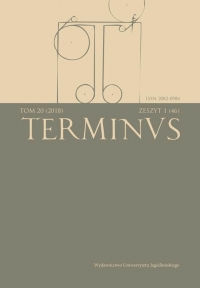„Longas carpere perge uias”. Rola wędrówki jako Owidiuszowego remedium amorisw strukturze kompozycyjnej Nadobnej PasqualinySamuela Twardowskiego
”Longas carpere perge uias”.The Role of Wandering as Ovid's remedium amoris in the Compositional Structure of Samuel Twardowski’s Nadobna Pasqualina
Author(s): Patryk Michał RyczkowskiSubject(s): Cultural history, Social history
Published by: Wydawnictwo Uniwersytetu Jagiellońskiego
Keywords: Ovid; Samuel Twardowski; elegy; epic; epyllion; romance; love; illness; allegory;topos of wandering
Summary/Abstract: In the paper, the author juxtaposes and compares Ovid’s Remedia amoris and Nadobna Pasqualina by Samuel Twardowski in order to show how the genre convention of the Latin love elegy influenced the shaping of the Polish Baroque poem. The plane of comparison is formed by selected compositional and content elements, that is the compositional frame based on the epic convention, together with the definition of poetic aims and assumptions, and the topos of love as a disease, characteristic of the elegiac, along with a healing journey. So far Twardowski’s work has been described as a “spiritual romance” (romans duchowny), although such classification is unsatisfactory and the notion itself is vague. In more recent studies, therefore, attention is drawn to the need for a broader look at the genre form of Nadobna Pasqualina and allows for the coexistence of elements specific to different literary genres. Starting from this postulate, the author briefly describes the assumptions of genre classification based on genological constructivism and distances himself from the concept of the spiritual romance, emphasizing the epic qualities of Nadobna Pasqualina, also those that bring it closer to the epyllion and highlight the dialogue of various components (part one). Therefore, the epic frame of the work does not exclude the exposure of the elegiac motif of love as a disease and wandering as a cure. The main part of the argument is divided into five parts (2–7). The second part of the study discusses the epic compositional frame of Twardowski’s work and his self-representation as a narrator of the poem about love struggles that is stylised as a story of war and displays didactic tendencies. The third part is devoted to the compositional frame of Remedia amoris, which places Ovid’s work within the convention of love didacticism. In addition, it revaluates the motifs of war and love presenting them as an illness and emphasizes the need for medicinal products, which are the subject of the elegy. In the fourth part of the study, the author reinterprets Pasqualina’s unfortunate love as a condition requiring treatment. Consequently, the fifth part is devoted to the comparison of how Twardowski and Ovid shaped this topos. Both suggest that one cannot get rid of love. It is only possible to immune oneself to love's destructive influence by strengthening the forces of reason (firmitas mentis, “the other armed thought” – myśl insza uzbrojona,and the talisman of wisdom). In Ovid's work, the journey is perceived only as a moving away from the source of love, which makes it possible to gain distance, while in Twardowski's poem its didactic value and the need for self-improvement are also emphasized. The sixth and seventh parts of the paper concern the compositional role of related topoi of love as a disease and wandering as a cure. For Ovid, they are one of many remedia which he describes in his elegy, consistently striving for poetic fame (part six). Twardowski, in turn, uses them to shape the composition frame and fill it with an allegorical story about the need for self-improvement (part seven). The conclusions of the analysis are presented in the summary (part eight). In both works, the journey has a therapeutic and didactic character and is connected with love understood as both war and illness. For Ovid, however, it is only a literary topos, while in the case of Pasqualina it enables Twardowski to shape the content and composition of a multidimensional allegorical work. As a typical elegiac motif, it co-shapes and enriches the genre form of Nadobna Pasqualina, which derives from the epic, and should not therefore be limited only to the heretofore accepted category of spiritual romance.
Journal: TERMINUS
- Issue Year: 20/2018
- Issue No: 3 (48)
- Page Range: 311-350
- Page Count: 40
- Language: Polish

